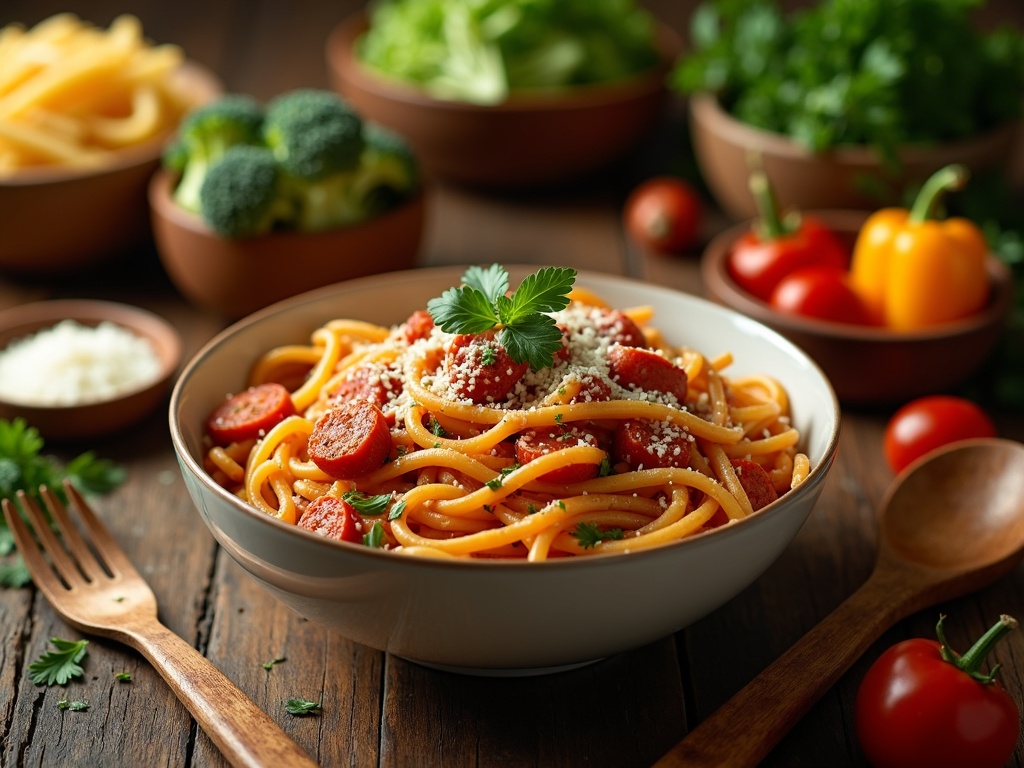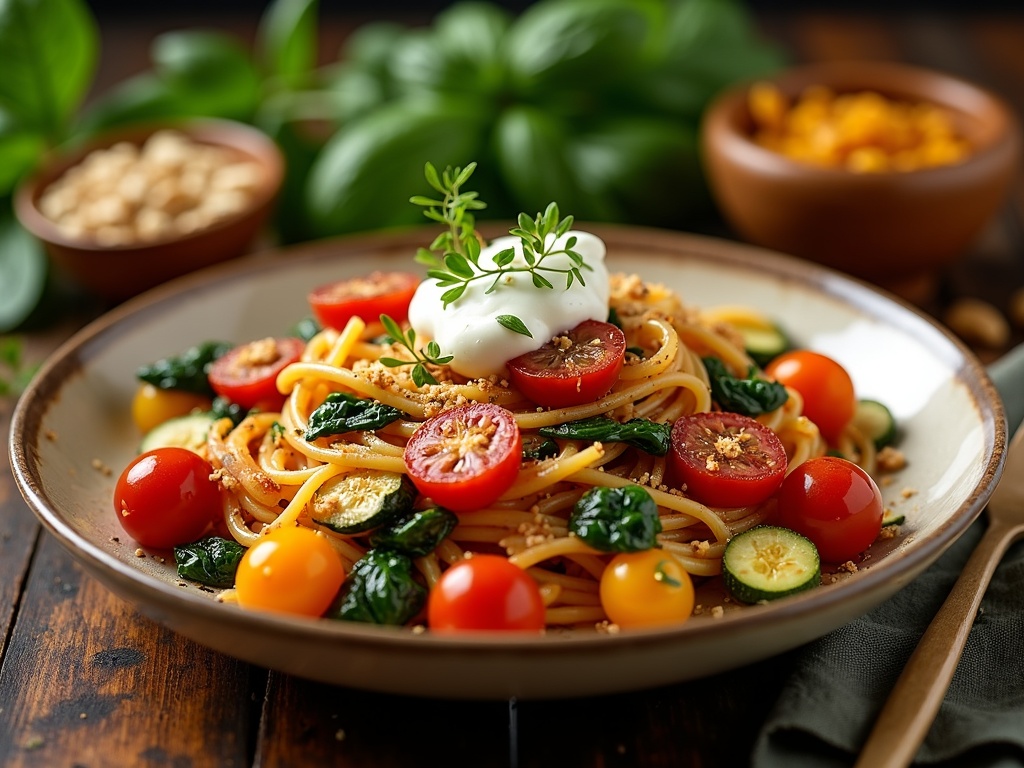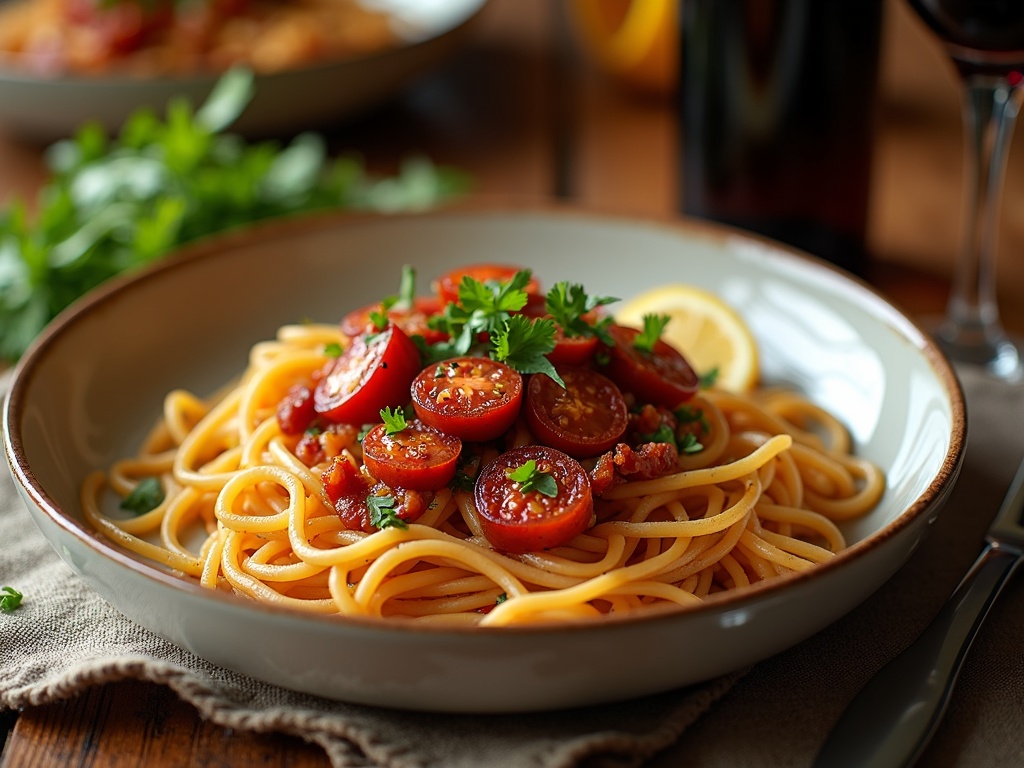Chorizo pasta blends the smoky, spicy flavors of this distinctive sausage with pasta to create a bold, satisfying meal with international appeal. Spanish chorizo offers smoky paprika notes while Mexican chorizo brings fresh chili heat. This adaptable dish delivers protein-rich comfort in every bite while letting you customize it to your exact taste preferences.
Find In This Article
Key Takeaways
- The type of chorizo you choose—Spanish (cured, ready-to-eat) or Mexican (raw, needs cooking)—dramatically affects your pasta dish’s flavor profile and texture.
- For the best flavor development, always brown chorizo before adding other ingredients to activate the Maillard reaction and release its flavorful oils.
- Pasta shape matters—short pasta like penne works well with chunky chorizo pieces while long pasta like spaghetti is ideal for smoother sauces.
- A typical serving of chorizo pasta contains 400-600 calories and about 22g of protein, making it a satisfying but occasional indulgence.
- The dish can be easily adapted for dietary needs by using plant-based chorizo, gluten-free pasta, or incorporating seasonal vegetables for added nutrition.
Spice Up Your Pasta Game with Chorizo
I’ve found that adding chorizo to pasta dishes creates an incredible flavor explosion that transforms an ordinary meal into something truly special. The rich, spicy notes of chorizo complement the neutral canvas of pasta perfectly, creating a satisfying dish that’s both bold and comforting.
Understanding Your Chorizo Options
Before jumping into cooking, it’s important to know which type of chorizo you’re working with as it dramatically affects your final dish. There are two main varieties that offer distinctly different cooking experiences:
- Spanish chorizo is already cured and ready to eat, similar to salami. It’s packed with smoky paprika flavors and has a firm texture that holds up well when sliced and added to pasta. The deep red color comes from the generous amount of paprika, lending a distinctive smokiness to any dish.
- Mexican chorizo, on the other hand, is a raw meat product that needs to be cooked before eating. It features fresh chilies rather than paprika as its main flavoring component, creating a brighter, more immediate heat. This version crumbles as it cooks, distributing evenly throughout pasta sauce.
Pasta’s versatility makes it the perfect partner for chorizo – no wonder pasta represents 12% of the global meal solutions market! The combination offers endless possibilities for quick, flavorful meals.
For a successful creamy pasta with chorizo, I start with these core ingredients:
- Chorizo (Spanish or Mexican depending on desired outcome)
- Pasta (penne works great for catching meaty bits, while spaghetti or fettuccine create a more elegant presentation)
- Fresh garlic (2-3 cloves minimum)
- Onions (yellow or red both work beautifully)
- Olive oil
- Salt and pepper
The beauty of chorizo pasta lies in its adaptability to different sauce styles. For Spanish chorizo, I often lean toward a tomato-based sauce that complements its smoky profile. The acidity of tomatoes balances the rich, cured meat beautifully. Simply sauté sliced Spanish chorizo until it releases its oils, add onions and garlic, then introduce crushed tomatoes and simmer.
When working with Mexican chorizo, I’ve had great success with both sauce styles. For a cream-based option, I brown the chorizo thoroughly, drain excess fat if needed, then add heavy cream, letting the spices from the meat infuse the sauce. The result is a decadent, spicy cream sauce that clings perfectly to pasta.
The flavor profiles of each chorizo type create distinctly different pasta experiences. Spanish chorizo delivers a deep, developed smokiness with notes of garlic and paprika that permeate the entire dish without overwhelming it. It maintains its texture during cooking, offering satisfying meaty bites throughout.
Mexican chorizo brings a fresher, more vibrant heat from its chili seasoning. As it cooks, it breaks down and integrates completely with the sauce, creating a consistent spicy flavor in every bite of your pasta creation.
I’ve found that finishing either style with a handful of freshly chopped parsley or cilantro adds a welcome brightness that cuts through the richness. A squeeze of lemon juice can also elevate the dish, particularly with Spanish chorizo, by balancing the smoky notes with acidity.
For an extra dimension of flavor, adding a small amount of the pasta cooking water to your sauce creates a silky texture that helps the sauce adhere better to the pasta. The starch in this water acts as a natural thickener and emulsifier for a more cohesive final dish.
Make The Perfect Chorizo Pasta
Cooking a delicious pasta dish with meat is all about timing and technique. The rich, smoky flavor of chorizo combined with perfectly cooked pasta creates a meal that’s both satisfying and impressive. I’ve perfected this recipe through countless attempts, and I’m excited to share my tips for creating a chorizo pasta that will have everyone asking for seconds.
Preparation and Ingredient Proportions
Starting with the right ingredients in proper amounts makes all the difference. For a meal serving four people, you’ll need:
- 250g spaghetti or your preferred pasta shape
- 150g chorizo, sliced or diced
- 400g canned tomatoes
- 3 cloves garlic, finely chopped
- 1 medium onion, diced
- 2 tablespoons olive oil
- Salt and pepper to taste
- Fresh herbs for garnish (optional)
The first step is crucial: always brown the chorizo before adding other ingredients. This activates the Maillard reaction, which creates complex flavor compounds that give your dish that irresistible depth. I heat a pan to medium-high, add the chorizo without oil (it releases its own), and cook until it develops a beautiful caramelized exterior.
Once the chorizo has browned, I immediately add the garlic and onions to the pan. This timing is important because the aromatic oils from the garlic and onions will infuse into the chorizo fat, creating a flavor base that carries throughout the entire dish. Cook them until softened but not browned – about 3-4 minutes.
The pasta shape matters more than you might think. For chunky sauces with pieces of chorizo, I recommend short pasta shapes like penne, rigatoni, or fusilli. These capture bits of meat and sauce in their ridges and hollows. For a smoother sauce where the chorizo has rendered more fully, creamy pasta varieties like spaghetti or linguine work wonderfully, allowing the sauce to coat each strand evenly.
Perfecting Your Technique
Achieving the ideal sauce consistency can make or break your chorizo pasta. After adding the canned tomatoes to your chorizo, garlic, and onion mixture, I let everything simmer uncovered for about 15-20 minutes. This reduces the sauce and concentrates the flavors. If the sauce gets too thick, I add a splash of the pasta cooking water – the starch in this water helps bind the sauce to the pasta and creates a silky texture.
I’ve learned to avoid several common mistakes when cooking with chorizo:
- Don’t cook chorizo over high heat – it can burn easily due to its fat content
- Never overcook the pasta – aim for al dente as it will continue cooking slightly when mixed with the hot sauce
- Resist the urge to drain all the chorizo fat – it contains intense flavor
- Don’t skip the resting time – letting the dish sit for 2-3 minutes after combining allows flavors to meld
The pasta water is your secret weapon for a perfect sauce consistency. Before draining your pasta, save at least a cup of the starchy cooking water. Add it tablespoon by tablespoon to your sauce if it needs thinning, stirring between additions to check the consistency.
For an extra flavor dimension, I sometimes finish my pasta with chorizo with a sprinkle of aged cheese or a drizzle of good olive oil. These final touches elevate the dish from good to memorable.
When serving, I prefer warm plates to keep the dish at the perfect temperature longer. A beautiful pasta with chorizo deserves to be enjoyed at its best – steaming hot with all flavors in perfect harmony.
Nutritional Information You Should Know
Understanding the nutritional profile of chorizo pasta helps you make informed decisions about how it fits into your diet. This hearty dish packs quite a punch in terms of both flavor and calories.
Macronutrients and Key Values
A cup serving of chorizo pasta typically contains between 400-600 calories, with the variance largely dependent on your sauce choice. The protein content is impressive at approximately 22g per serving, making it a satisfying option for muscle recovery or keeping hunger at bay.
I’ve found that sodium levels in chorizo pasta dishes range from 600-800mg per serving, which is something to monitor if you’re watching your salt intake. Chorizo itself contributes significantly to this sodium count.
Fat content in chorizo pasta is generally higher than traditional pasta dishes. While a standard pasta with tomato sauce might contain 7-10g of fat per serving, adding chorizo can bump this up to 15-25g. This isn’t necessarily bad news—these fats contribute to the dish’s satisfying nature and help with vitamin absorption.
For those looking to modify this dish, consider these healthier alternatives:
- Substitute regular pasta with whole grain options for added fiber
- Try turkey or chicken chorizo instead of traditional pork versions
- Use lighter sauce recipes like tomato-based ones instead of cream-based sauces
- Add extra vegetables like broccoli or bell peppers to increase nutrient density
- Control portion sizes by pairing with a large salad
Your sauce choice dramatically impacts the overall nutritional profile. A creamy mushroom sauce will add significant calories and fat, while a simple olive oil and garlic base keeps things lighter. For a middle ground, pesto-based sauces provide healthy fats from nuts and olive oil.
I’d recommend treating chorizo pasta as an occasional indulgence rather than a dietary staple, particularly if you’re monitoring calories or sodium intake. When prepared mindfully with quality ingredients and reasonable portions, it can certainly be part of a balanced eating plan.

Creating Exciting Variations
The versatility of chorizo pasta makes it a perfect canvas for creative cooking. I’ve experimented with numerous variations that maintain the dish’s signature bold flavors while accommodating different preferences and dietary needs.
Plant-Based and Seafood Alternatives
Plant-based chorizo has come a long way in mimicking the smoky paprika-infused flavor profile of traditional chorizo. For a vegetarian twist, I substitute soy-based chorizo and pair it with roasted red peppers, spinach, and a splash of olive oil. The result is just as satisfying as the meat version, with all the characteristic spice and depth. This adaptation works particularly well in a creamy pasta format where the plant-based protein absorbs the richness of the sauce.
Seafood introduces a delightful coastal dimension to chorizo pasta. I often combine diced chorizo with shrimp or calamari for a Spanish-inspired dish. The natural sweetness of seafood balances perfectly against the spicy chorizo, creating a flavor combination that’s both complementary and complex. For a lighter option, I might incorporate these ingredients into a white sauce pasta base instead of a tomato one.
For those with dietary restrictions, several adaptations work beautifully:
- Gluten-free: Swap traditional pasta with corn, rice, or chickpea alternatives
- Dairy-free: Use nutritional yeast instead of cheese and plant-based milk for creaminess
- Low-carb: Replace pasta with zucchini noodles or spaghetti squash
Regional and Seasonal Inspirations
Different regions put their unique stamp on chorizo pasta. Portuguese versions often include more garlic and bay leaves, while Mexican interpretations might incorporate fresh cilantro and lime. An Italian-influenced pesto chicken pasta can be transformed by swapping the chicken for chorizo and adding a pinch of smoked paprika to the basil mixture.
Seasonal ingredients breathe new life into this dish throughout the year:
- Spring: Asparagus, peas, and fresh herbs
- Summer: Cherry tomatoes, zucchini, and fresh corn
- Fall: Mushrooms and butternut squash
- Winter: Kale, brussels sprouts, and leeks
Fusion combinations represent the cutting edge of chorizo pasta innovation. I’ve had great success pairing chorizo with Asian flavors like ginger and soy, or giving it a North African twist with harissa and preserved lemon. The key is maintaining balance—letting the chorizo’s distinctive flavor shine while introducing complementary elements that enhance rather than overwhelm.
For a simple yet impressive variation, try adding chorizo to a basic broccoli pasta dish. The spicy sausage transforms this everyday meal into something special, with minimal extra effort.
Perfect Pairings for Your Meal
Creating a complete dining experience with chorizo pasta means thinking beyond just the main dish. I’ve discovered that the right accompaniments can elevate this spicy, flavorful pasta into a memorable meal that will impress your guests.
Beverage Selections
When serving a robust chorizo pasta, the right drink pairing makes all the difference. A glass of Tempranillo works wonderfully with the spicy notes of chorizo, as its medium body and moderate tannins complement rather than overwhelm the dish. Grenache is another excellent choice, offering fruity notes that balance the savory elements of the pasta.
Statistics show that 65% of people prefer red wines when enjoying spicy dishes like chorizo pasta. However, if you prefer non-alcoholic options, a sparkling water with a squeeze of lime provides a refreshing contrast to the rich pasta.
For a complete pasta experience, you might also consider exploring other variations like creamy mushroom pasta or white sauce pasta for future meals.
Complementary Sides and Starters
A simple arugula salad with a bright citrus vinaigrette offers the perfect counterpoint to the richness of chorizo pasta. The peppery greens and tangy dressing cut through the fat of the chorizo while cleansing the palate between bites.
For balancing side dishes, consider:
- Roasted vegetables like bell peppers and zucchini, which echo the Mediterranean flavors
- Garlic bread with olive oil for dipping into the pasta sauce
- A light cucumber and tomato salad for freshness
Before serving your main course, whet appetites with small starters such as marinated olives, a simple bruschetta, or stuffed mushrooms. These appetizers set the stage without filling guests up before the broccoli pasta or your chorizo main dish arrives.
To finish your meal on a sweet note, lighter desserts work best after a hearty chorizo pasta. A lemon sorbet, fresh berries with a touch of honey, or even a simple almond biscotti with coffee provides just enough sweetness without overwhelming already-satisfied guests.
For a creamy variation on your pasta night, you might try creamy pasta recipes or pesto chicken pasta as alternatives that pair with many of the same sides.
Enhance Your Dish
I’ve found that the right finishing touches can transform a good chorizo pasta into an extraordinary culinary experience. With a few strategic additions and thoughtful presentation, your dish will not only taste better but also look restaurant-worthy.
Fresh Herbs and Vegetables
Fresh herbs breathe life into chorizo pasta dishes. I always keep a handful of chopped basil nearby when serving my pasta. The sweet, aromatic quality of basil creates a wonderful contrast to the smoky, spicy notes of the chorizo. Flat-leaf parsley adds a clean, bright flavor that cuts through the richness of the dish.
Adding vegetables elevates both the nutritional value and visual appeal of your pasta. I love tossing in:
- Roasted red and yellow bell peppers for sweetness and color
- Sautéed spinach folded in just before serving for a touch of earthiness
- Cherry tomatoes halved and added at the last minute for bursts of freshness
- Grilled zucchini for a smoky complement to the chorizo
- Thinly sliced red onions quickly pickled for a tangy contrast
For a complete meal with balanced flavors, consider adding broccoli to your pasta dish. The subtle bitterness pairs wonderfully with the rich chorizo.
Sauce Variations and Presentation
The sauce forms the foundation of any great pasta dish. While chorizo releases its own flavorful oils, I’ve experimented with several variations to suit different occasions:
For casual weeknight dinners, I keep it simple with olive oil and the natural juices from the chorizo. For special gatherings, I create a creamy sauce base that mellows the spice of the chorizo while adding luxurious texture.
When I’m craving something with depth, I incorporate a white sauce for my pasta that complements the chorizo without overpowering it. The cream sauce provides a perfect canvas for the spicy meat to shine.
Temperature and texture contrasts play a crucial role in elevating your dish. I serve my chorizo pasta piping hot but often add cold elements as garnish—like a dollop of cool crème fraîche or cold fresh herbs sprinkled at the last moment. This creates an exciting sensory experience with every bite.
For textural variety, I add toasted breadcrumbs or pine nuts as a finishing touch. The crunchiness against the al dente pasta and tender chorizo creates a delightful mouthfeel that keeps guests coming back for more.
Plating isn’t just for fancy restaurants—I’ve found that even simple presentation techniques make a difference. Rather than piling pasta onto plates, I use tongs to create a twirled mound in the center, then arrange the chorizo and vegetables thoughtfully around it. A drizzle of high-quality olive oil creates appetizing sheen.
For dinner parties, I serve chorizo pasta in warmed shallow bowls that showcase the ingredients. If you’re feeling adventurous, try combining pesto with chicken and pasta alongside your chorizo for an interesting fusion dish.
When I want something hearty yet sophisticated, I incorporate mushrooms into a creamy pasta base before adding the chorizo. The earthy mushrooms create a wonderful foundation for the spicy meat.
Garnishing is your final opportunity to impress. I arrange thinly sliced chorizo crisps on top for added texture, scatter microgreens for color, or add a light grating of hard cheese that melts slightly from the heat of the pasta below.

Sources:
Understanding Modern Pasta Consumption, The Food Institute, 2022
Nutritional Benefits of Chorizo in Cuisine, USDA National Nutrient Database
Cooking Techniques that Impact Flavor, Culinary Institute of America
Wine Pairing Preferences for Spicy Dishes, Wine Institute Survey, 2023

